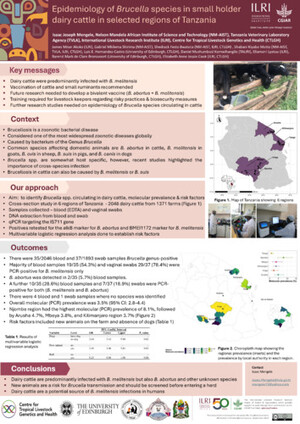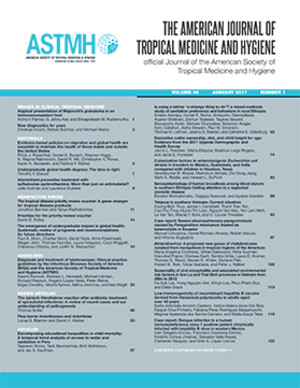
Sero-prevalence and risk factors associated with occurrence of anti-Brucella antibodies among slaughterhouse workers in Uganda
Abstract
Introduction
Brucellosis is a febrile zoonosis occurring among high-risk groups such as livestock keepers and abattoir workers and is a public health priority in Uganda. The technical complexities of bacteriological and molecular methods make serological approaches the cornerstone of diagnosis of human brucellosis in resource limited settings. Therefore, proper application and interpretation of serological tests is central to achieve a correct diagnosis.
Materials and methods
We conducted a cross-sectional study to estimate the seroprevalence and factors associated with anti-Brucella antibodies among slaughterhouse workers processing ruminants and pigs in three regions of the country with serial testing using a combination of the Rose Bengal Test (RBT) and the BrucellaCapt test. An authorized clinician collected 543 blood samples from consenting abattoir workers as well as attribute medical and social demographic data. Univariable and multivariable logistic regression were used to determine factors associated with anti-Brucella sero-positivity.
Results and discussion
The sero-prevalence among ruminant slaughterhouse workers ranged from 7.3% (95% CI: 4.8–10.7) using BrucellaCapt to 9.0% (95% CI: 6.3–12.7) using RBT. Slaughterhouse workers from the Eastern regions (AOR = 9.84, 95%CI 2.27–69.2, p = 0.006) and those who graze animals for alternative income (AOR = 2.36, 95% CI: 1.91–6.63, p = 0.040) were at a higher risk of exposure to Brucella. Similarly, those who wore Personal Protective Equipment (AOR = 4.83, 95%CI:1.63–18.0, p = 0.009) and those who slaughter cattle (AOR = 2.12, 95%CI: 1.25–6.0, p = 0.006) were at a higher risk of exposure to Brucella. Those who slaughter small ruminants (AOR = 1.54, 95%CI: 1.32–4.01, p = 0.048) were also at a higher risk of exposure to Brucella.
Conclusions and recommendations
Our study demonstrates the combined practical application of the RBT and BrucellaCapt in the diagnosis of human brucellosis in endemic settings. Both pharmaceutical (e.g., routine testing and timely therapeutic intervention), and non-pharmaceutical (e.g., higher index of suspicion of brucellosis when investigating fevers of unknown origin and observation of strict abattoir hygiene) countermeasures should be considered for control of the disease in high-risk groups.
Citation
Bugeza, J.K., Roesel, K., Mugizi, D.R., Alinaitwe, L., Kivali, V., Kankya, C., Moriyon, I. and Cook, E.A.J. 2024. Sero-prevalence and risk factors associated with occurrence of anti-<i>Brucella</i> antibodies among slaughterhouse workers in Uganda. <i>PLOS Neglected Tropical Diseases</i> 18(3): e0012046.










